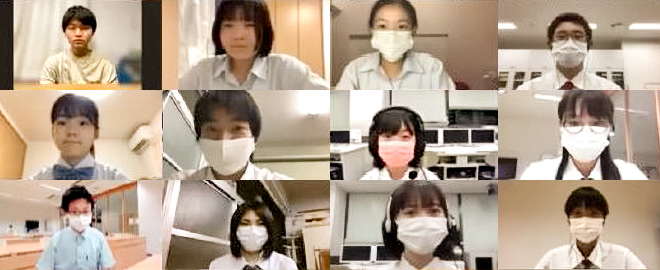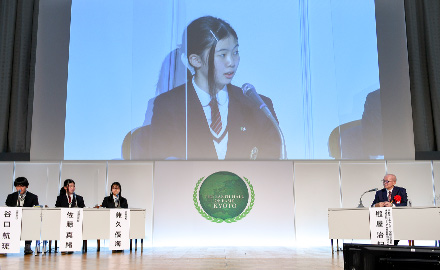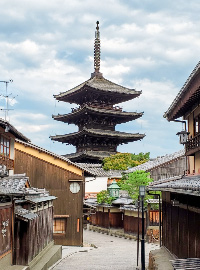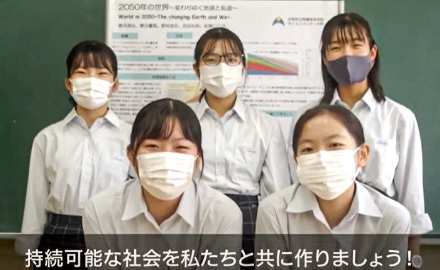The Study Program on Climate Change for High School Students began in 2019 in Kyoto, birthplace of the Kyoto Protocol. The Kyoto prefectural and city governments, and the Research Institute for Humanity and Nature collaborate to implement the program, with cooperation from Kyoto's prefectural and city education boards, and others.
It conducts intensive courses on climate change, presented by leading figures, aimed at high school students in Kyoto Prefecture. The students experience cutting-edge knowledge, and through group workshops and the like, they consider what they can do for local and social transformation, and share ideas they have gathered with the wider society.
There are also opportunities for students to present what they learned through the Climate Change Learning Program, in collaboration with the Earth Hall of Fame Kyoto, an award to honor in perpetuity the achievements of those who have contributed to conservation of the global environment, and the Kyoto Environmental Culture Academic Forum international symposium.
This website was prepared with the aim of creating opportunities to study together with high school students overseas.
Let us learn together.
Message
YAMAGIWA Juichi
Director-General, Research Institute for Humanity and Nature
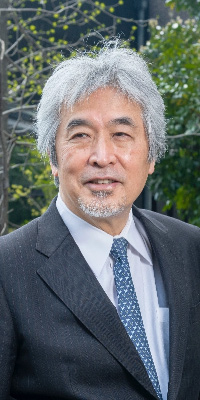
Considering Questions about Our Future Raised by Climate Change
Until very recently, we believed that humans had gained control over the Earth. Information and communications technology have enabled us to connect in any part of the planet, we successfully manipulated genes to create organisms to suit human needs: we were truly acquiring "the hand of God." But over the past two years, as we suffered the COVID-19 pandemic, we have realized that this planet is actually under the control of invisible bacteria and viruses. Many living creatures, including we humans, have genes that originated from bacteria and viruses. Over 100 trillion bacteria coexist in human intestines, helping to balance our body and mind. Humans and the Earth are in a symbiotic relationship with many living creatures and viruses.
So why do viruses that were in symbiosis with living creatures now cause us illness? One of the causes is climate change. With warming and violent changes in the climate, viruses that developed symbiotic relationships over a long period in the great biodiversity of rain forests and oceans are producing new variants that infect livestock and humans. The cause of this climate change is rapid increase in human impact on the environment in recent years.
In 100 years, the Earth's population has quadrupled and is now 7.8 billion. Cattle, pigs, goats and other livestock each number over a billion head. Now, humans and livestock account for 90 percent of the world's mammalian biomass. Forty percent of land has been turned into farmland or pasture to feed humans and livestock, and now just 30 percent of high biodiversity forest remains. Population is concentrated in cities, waste chemical substances pollute the atmosphere, soil, rivers and oceans, and climate change caused by greenhouse gases is accelerating.
Recent years have seen frequent earthquakes and tsunami. Volcanic eruptions, forest fires and other natural disasters also result from climate change, and with temperatures warming, the North Pole ice is melting, glaciers are disappearing, rising sea temperatures are changing the distribution of plants and animals, and habitat destruction has put many species in danger of extinction. Climate change is causing droughts and floods, and crop failure and starvation threaten survival, forcing more people to leave their homelands as refugees.
The Kyoto Protocol, ratified in 1997 at the United Nations Framework Convention on Climate Change (COP3), established the world's first numerical targets with legally binding power for the reduction of greenhouse gas emissions by advanced nations. The Sixth Assessment Report of the Intergovernmental Panel on Climate Change (IPCC), released last year, stated "It is unequivocal that human influence has warmed the atmosphere, ocean and land." In addition, the world's ground surface temperature has risen 1.09ºC compared with that from 1850 to 1900, of which 1.07ºC is considered to be due to human factors. In order to curb this, under the Paris Agreement, adopted at COP21 in 2015, signatories agreed to pursue efforts to limit average global warming from 2020 to well below 2ºC, and preferably to 1.5ºC, compared to pre-industrial levels. Last year, at COP26, a target of 1.5ºC was officially specified, and many countries declared their commitment to net-zero greenhouse gas emissions by 2050. Japan also agreed to this and announced that it would reduce greenhouse gas emissions 46% by 2030.
But this goal cannot be achieved easily. We have increased use of hydro, wind and other natural energy to replace thermal power, and have begun to develop various technologies, such as filters to absorb carbon dioxide, and ways to utilize hydrogen, but if we continue our existing way of life, with mass-production and mass-consumption prioritizing the economy, clearly we will be pushed to the limit at some point. We must drastically alter our lifestyles to prevent a global environmental catastrophe.
For 20 years, the Research Institute for Humanity and Nature has considered that "the roots of global environmental problems are found in human culture," and has conducted transdisciplinary research with participation from diverse academic fields, government, and citizens. Last year, in collaboration with Kyoto Prefecture and Kyoto City, we established a Climate Change Adaptation Center, which examines the effects of recent climate change and considers countermeasures. Climate change is an issue facing all people on the Earth, and at the same time, the effects and approaches to handle it differ according to various natural and cultural characteristics. In this time of great change, I expect that discussions transcending regional and national differences will be very important for imagining an abundant future for the Earth and humankind.
Program The Study Program on Climate Change for High School Students in Kyoto 2021
Participating High School
Kyoto Kogakuin High School, Sagano High School, Tonan High School, Hokuryo High School, Mineyama High School, Momoyama High School, Jonan Ryoso High School, Nanyo High School, Fukuchiyama High School, Murasakino High School, Horikawa High School, Ritsumeikan Uji High School
Outline of Study Session
*Conducted online via zoom *Positions and titles are as of the time.
1st Study Session: Climate Change (basic study)
June 18, 17:00-19:00
KIHARA Hirotaka (Deputy Director, Kyoto Center for Climate Actions / Visiting Associate Professor, Research Institute for Humanity and Nature)
2nd Study Session: Climate Change (applied learning)
July 28, 17:00-19:00
EMORI Seita (Earth System Division Deputy Director, National Institute for Environmental Studies / Visiting Professor, Research Institute for Humanity and Nature)
3rd Study Session: Climate Justice
August 18, 15:00-17:00
USAMI Makoto (Professor, Kyoto University Graduate School of Global Environmental Studies)
Interaction and Dialogue with Inductees the 12th Earth Hall of Fame KYOTO
Participation in the Earth Hall of Fame KYOTO and the International Symposium and the Kyoto Academic Forum on Environment and Culture. Participants had a conversation with Hall of Fame inductee TSUCHIYA Haruki, and received video messages from international Hall of Fame inductees.
November 15 Afternoon
Studies
1st Study Session: Climate Change (basic study)

■Watching the presentation by Greta Thunberg
Greta Thunberg is sending a severe message directed at adults who are trying to steal away our future. Around the world, young people are raising their voices under the name of "Fridays For Future." It is also taking place in Kyoto. I have heard that when surveys are held in Europe, politicians cannot gain votes from young people unless they say that they will tackle the climate change problem. How about in Japan? This is spreading in Kyoto. What does everybody think when they hear about such initiatives?
(1) Rising temperatures
There is no room for debate regarding the question of whether temperatures are rising. This is due to the impact of CO₂, methane and other factors.
(2) The global warming mechanism
Infrared radiation that should escape to space is unable to exit the atmosphere, causing global warming.
(3) Do humans cause global warming?
People ask "Are humans really causing it?," but according to the latest report of an international organization, it is over 95% certain that humans are causing global warming. How do you all perceive this figure? (Later reports state that there is "no room for doubt.")
(4) What will happen to temperatures from now on?
The future is not set, therefore it will change depending upon what we do from now on. If we continue with the same level of global warming countermeasures as now, it is said that temperatures will rise by about four degrees by 2100. Greta says that "It is unacceptable to have society handed down to us with temperatures rising in this way."
For example, July 2018 was extremely hot in Japan, and over 1,000 people died from heatstroke in one month. Since the Industrial Revolution, humans have burned fuels and emitted carbon dioxide. There is research that suggests that temperatures would not be as high as they are if global warming caused by carbon dioxide emissions had not occurred.
(5) Zero CO₂ emissions
Basically, global warming will not stop unless we reduce our emissions of CO₂, etc. to zero. We need to curb the temperature increase since the Industrial Revolution to 1.5 degrees, but because temperatures have already risen 1 degree, we now know that we must reduce emissions to zero by 2050 to suppress the temperature increase to the remaining 0.5 degrees.
(6) Aiming for zero CO₂
Currently, we burn fossil fuels to obtain energy. We should use it efficiently, and reduce energy consumption. Where we need energy, we should supply this through renewable energy. For the portion where we must use fossil fuels, we should plant many trees and absorb CO₂ using devices and so on.
(7) Major trends
For example, under the Paris Agreement, realized in 2015, the world has already agreed to reduce CO₂ emissions to zero in the future. Naturally, Japan has also agreed. We will reduce CO₂ emissions to zero by 2050. We know that we must roughly halve CO₂ emissions by 2030. This must be the minimum standard in creating our future lifestyles, industries and communities.
Japan has also announced its aim to reduce its CO₂ emissions to 46% in 10 years, by 2030. Kyoto Prefecture and Kyoto City are also saying they aim for zero CO₂ emissions. Various companies have also declared that they will only use natural energy. Even local governments are starting to make similar declarations. For example, Fukuchiyama City Council in Kyoto Prefecture has declared that it will only use renewable energy.
(8) Case study: Toyota Motor Corporation
Toyota, for example, says that it will achieve zero CO₂ emissions in its entire value chain by 2050. The value chain refers to all of its business partners. They will ensure zero CO₂ emissions to the last screw and drop of paint. If companies do not comply, they will not be able to do business with Toyota.
(9) What is happening around the world?
The U.K. has declared that it will prohibit the sale of gasoline and diesel operated cars by 2030. Norway has stated that it will prohibit their sale even sooner, by 2025. Germany and France also announced that they will prohibit their sale, by 2040.
(10) Renewable energy.
Solar power generation was popularized around 1990 in Japan, enabling it to produce electricity from renewable energy at a top-class level worldwide. But since then, Japan has not made any progress in power generation through renewable energy. In the U.K., the proportion of renewable energy power generation has increased through construction of many offshore wind power generators. Even in Germany, power generation through renewable energy now accounts for approximately 40% of the total. In Denmark too, it is increasing implementation at a much faster rate than its targets. In Austria, they produce roughly 90% of electricity through green energy. I certainly hope you investigate the question "How high is the amount of power generated through renewable and green energy?"
(11) Awareness of climate change and global warming
The more we understand how serious the global warming problem is, the more it makes some research results almost unbearable. According to another survey regarding global warming countermeasures, 60% of respondents in Japan answered either that measures were "harsh" or "necessary, but harsh." In various foreign countries, many respondents answered that "by implementing global warming countermeasures, the quality of life will be better," or "living standards will improve." How should we view such results?
2nd Study Session: Climate Change (applied learning)

(1) Changes in the global average temperature
The global average temperature fluctuates but is gradually rising. When compared from year to year, fluctuation is irregular, but viewed over the long-term, the temperature is clearly increasing.
(2) Temperature change and human activity
Scientists use computer simulation to investigate the global average temperature over the past 100 years. They use numeric formulas based on the laws of nature, worked out by computer, which also enables them to conduct experiments that would not be possible in the real world. Without factoring human activity into calculations, the temperature increase that has actually occurred cannot be explained.
(3) Temperature change over a longer time span
Long ago, temperatures rose and fell due to factors such as fluctuations in solar activity, but this fades in comparison with temperature increases caused by humans. Past data was not measured by thermometers, but using data estimated from growth rings in trees and the like. Although there is some uncertainty, these are the latest results of data collected by various researchers around the world. Even looking at the past 2,000 years, the recent temperature change is exceptional.
(4) CO₂ concentration
Temperatures rise and fall between glacial and interglacial periods, CO₂ concentration variation is approximately 100 parts per million (ppm). In comparison, CO₂ emitted through human activity from prior to the Industrial Revolution until now is said to have already raised the concentration approximately 130 ppm. The change caused by humans over the past 200 years is greater than the variations of natural change on the Earth over roughly 100,000 years.
The impact on the planet from human activity is even greater than that from fluctuations in solar activity, and consequently, we are living in an extraordinary era for the Earth. We call this era the "Anthropocene epoch," and humans should be aware that they are living in a time when their impact on the Earth is the greatest ever.
(5) What happens as a result of global warming?
Firstly, abnormal weather is increasing. Abnormal weather is defined as events that occur less than once in 30 years. The present temperature is on a long-term upward trend. Consequently, when fluctuations swing to extremes, compounding increases in the average lead to more record temperatures. What happens as a result of these extreme changes? Sea levels rise. Floods occur. The increase in temperature causes an increase in water vapor in the atmosphere, so when heavy rains occur, it produces more water vapor, causing more record-breaking rains. Also, when there is more water vapor, more typhoons occur. Compounding temperature increases also result in record-breaking heat waves.
Rising sea levels in particular cause greater flood damage in coastal developing nations such as Bangladesh and small island nations such as Kiribati and Tuvalu, and it is said that countries may eventually cease to exist. It also causes people to become refugees. Problems of food security and water resource shortages are seen especially in developing nations in dry regions. Global warming is causing more droughts in countries in central Asia and Africa, resulting in loss of food, income and water.
(6) Inequitable structure
This is not the fault of the people living in those countries, rather, the problems are being caused by CO₂ emissions from people in developed and emerging nations. Although people in developing nations do not emit much CO₂ in comparison with people in developed and emerging nations, many of them suffer effects that are a matter of life or death. The structure is highly inequitable.
Also, it is an even more serious issue for future generations. As global warming becomes more severe in the future, they must live longer on the Earth with more terrible effects. This is surely extremely unfair, because this was caused by previous generations. There is also damage to ecosystems. I hope that you will learn about these structures.
(7) CO₂ emission volumes in Japan
CO₂ emissions fell slightly last year, due to the impact of the COVID-19 pandemic. It is believed that CO₂ emissions for the year of 2020 fell 7% compared with 2019. By chance, we tested how CO₂ emissions would drop if the economy was stopped. But reducing CO₂ emissions through restraint of the economy was not the method we originally planned.
(8) How will we cut CO₂ emissions?
Firstly, there is energy conservation. There is also renewable energy. There are no CO₂ emissions from nuclear power generation, but there is the risk of accidents, and waste material is an issue. Thermal power stations burn coal and natural gas, but people are considering applying a method whereby they do not release CO₂ into the atmosphere, but instead, the CO₂ emitted is buried in holes dug underground. But given the cost involved, whether or not it would really be implemented is another matter.
There is also the option of replacing fuel for cars and airplanes with electricity, hydrogen or biomass. It would also be good to absorb CO₂ from the atmosphere if that is possible. But this would also cost. There are also side effects. Whether or not it would really be implemented is another matter.
(9) Countermeasures
Between 2008 and 2012, when CO₂ emission volumes were cut in line with the Kyoto Protocol, realized in 1997, countries maneuvered to force CO₂ cuts onto other countries due to the economic burden entailed.
Now is the era of the Paris Agreement. It is said that the paradigm has altered. Technology changes have been incorporated. The cost of solar and wind power generation has become cheaper, for example. Many places are emerging around the globe where these options are cheaper than thermal power, and renewable energy is growing rapidly. We are seeing a scramble for economic opportunities, as people ask how to commercialize renewable energy and maximize profits.
(10) Japan's movements
Currently, thermal power generation supplies most electric power in Japan, but it is estimated that approximately double of the current energy needs could be produced using renewable energy. Of this, 60% would be offshore wind power, 20% would be onshore wind power, and 20% would be solar power. This could increase further if the economics improve.
There are also issues. Producing electricity using renewable energy still costs more in Japan than it does overseas. There is also the issue of correcting indiscriminate development. While we need to increase the amount of electricity generated by renewable energy as quickly as possible—this is an extremely big challenge.
(11) What can we do now?
Compare this with the COVID-19 pandemic. During the COVID-19 pandemic, we wear masks, wash our hands, use disinfectant, maintain distance, and go out as little as possible. How long can we continue this? In terms of an exit, we can achieve herd immunity when vaccines and therapeutic drugs are available to all, and so it is suggested that we continue our actions until this happens.
Regarding the environmental crisis, it is often suggested that what we can do is turn off lights that we do not need, and so on. How long should we continue this? In short, until we achieve decarbonization. If this is the case, then each individual should not just change their behavior, such as by switching off lights, but should give their support to quickly increasing power generation from renewable energy. We should back such activities, accelerate the process, and show interest as individuals, speaking to friends, and sharing on social media. I also believe that we each as individuals should support companies and politicians who are doing their best in such activities, and take part in local government initiatives.
(12) Thinking of an even bigger exit
"Shouldn't we aim for an even bigger exit?" We might, for example, be able to repress COVID-19 by ensuring that vaccines and therapeutic drugs are available to all. But it is also said that the next virus will soon emerge. This is because, when humans intrude into ecosystems, clear forests, hunt wild animals for food, and go sightseeing, it can allow viruses from wildlife to enter human society. After a virus enters, if there are disparities in society, people who are in a more vulnerable social position will suffer more acute harm. This causes a scramble for vaccines and pushing the blame onto others.
There are probably similarities in regards to climate change. Even if we were to replace all technologies, and even if we no longer emit CO₂, this does not necessarily mean that all people will be happy. We must think about how to exit from such major problems.
3rd Study Session: Climate Justice

(1) Two meanings of climate justice
I would like to begin by saying that the term of "climate justice" has two meanings. The first can be called climate justice as theory, which refers to the whole body of literature on philosophical/ethical issues surrounding justice as well as responsibility in the context of climate change and climate change policies.
The second meaning is climate justice as practice. Those who suffer from particularly serious adverse impacts of climate change include indigenous peoples (e.g., Native Americans in the United States), racial minorities (e.g., African Americans), and low-income households. The term of "climate justice" has been used as a slogan in political and social movements created and developed on behalf of such people.
(2) Climate justice as theory
The study on climate justice emerged in the beginning of the 1990s. Emissions of carbon dioxide (CO₂) per capita in developed countries are admittedly much higher than in most of developing countries. On the other hand, greater negative impacts have been observed in the Global South than in the Global South. Thus, it seems that economically advanced societies have a special responsibility in relation to climate change. If this is the case, how can we rigorously explain their responsibility? This is the question of which many theorists of climate justice conceive.
Generally, climate change policies fall into two broad categories: mitigation and adaptation. Looking at mitigation, the substantial part of the climate justice study has examined the question of what principle governing the global distribution of rights to emit CO₂ among all individuals across the world is just. In order to answer this question, theorists have applied observations made in the field of distributive justice, which refers to the philosophical study on just distribution of benefits or burdens among individuals, to the context of climate change. Another primary issue comes from the fact that climate change is expected to be exacerbated at an accelerating pace for many decades or even many centuries. Given this fact, does the present generation have a responsibility towards future generations? If it does, what does that responsibility require us to do? These and related questions have been explored by philosophers for several decades.
(3) What climate justice theory tell us
We are frequently given clichés such as "don't waste electricity," which are said to be effective in mitigating climate change. Although these clichés are not meaningless, individual behaviors are not enough at all, and system changes would be essential in fighting climate change. Theories of climate justice can tell us moral grounds for creating new systems and policies to mitigate climate change in a fair way.
(4) What climate justice movements make us realize
There are three types of disparity related to climate change. The first type is what we can call emissions disparity: developed countries have emitted much more CO₂ than most of developing countries, and the world's richest than the poor. The second can be termed impacts disparity: those living in the Global South, more particularly the socioeconomically disadvantaged living there, suffer from acute adverse impacts of climate change. Third, countermeasure disparity also deserves a special attention. In the global community and each country therein, it is poor and vulnerable people who tend to experience greater disadvantages from mitigation or adaptation measures. The climate justice movement emerged against the backdrop of the three disparities. The new social systems and measures needed to mitigate climate change should not force disadvantaged or vulnerable people to make sacrifices. We will need systems that protect the basic interests of such people and that compensate them if they suffer from harm. This is what climate justice movements make us realize.
(5) What should we do?
I suggest to you that you do three things about climate change. First and foremost, I urge you to listen carefully to what scientists say. Don't be deceived by pseudoscientists' climate change denials. Next, I want young people to express their candid opinions, which I hope are based on scientific knowledge, without worrying what others would think about the opinions. Furthermore, you are advised to ask yourself what you can do toward a change in institutional arrangements and public awareness of climate change issues.
(6) Era of young people
Anthropogenic climate change is a novel type of global problem, which humanity has never faced. Good faith everyday behaviors of individuals would not be enough to curb climate change even slightly; rather, we need to drastically change social institutions and arrangements. The problem is that middle-aged people including me, not to mention the elderly, have been accustomed to the existing social structures and thus are not good at proposing any radical change in the structures. In contrast, I believe that young people have great potential as innovators of social institutions and arrangements. It is now the era of the youth. Don't leave it up to middle-aged or elderly people, who are responsible for the current and future dismal consequences of climate change. Your new ideas and vitalities are definitely needed to struggle against such a huge challenge.
Interaction and Dialogue with Inductees the 12th Earth Hall of Fame KYOTO
Participation in the Earth Hall of Fame KYOTO and the International Symposium and the Kyoto Academic Forum on Environment and Culture. Participants had a conversation with Hall of Fame inductee TSUCHIYA Haruki, and received video messages from international Hall of Fame inductees.
Presentations from Students
Let's Learn Together! Call for Participating High Schools
We would like to create an opportunity for Japanese high school students who have learned about "climate change" to discuss it with high school students from other countries. Let's discuss and learn together.
Voices of High School Teachers

Efforts to Change Perceptions on Climate Action through EducationAOKI Takahiro (Teacher, Kyoto City Tonan Senior High School)
Three students from our school took part and, along with learning about the climate crisis, they proposed educational reform as a climate action aimed at its resolution.
Prior to joining this event, the students seemed to have the impression that climate change was difficult, that they did not understand it well, and that, despite hearing about the climate crisis, it was hard to know what to do. But through the event, they learned about the climate crisis in a multifaceted way, including social psychology, natural science, and ethical aspects, which helped to change their awareness significantly. They were surprised, for example, by the fact that "Japanese people hold a considerably more negative view of climate action compared with other countries" and were very interested in how such perceptions could be changed. The educational reform they proposed as a solution to the climate crisis emerged precisely from a desire to change these perceptions held by Japanese people with education. In this way, the event not only increased the students' understanding of the climate crisis, it was also a good opportunity for them to consider action to address the crisis.
For myself as a teacher, it also contributed to follow-up educational activities. I was able to learn about various climate research, and also learned about teaching methods, such as effective ways to show a graph to students to promote their consideration. The students' advocation of educational reform was at the same time a message telling me to reform education, and I therefore hope to take up the challenge to use what I learned at this event in the education field to meet their hopes.

Participation in the Climate Change Study ProgramNAKANO Genta (Teacher, Kyoto Prefectural Hokuryo Senior High School)
As with last year, all study sessions were conducted online, but a result of the online exchange that has become mainstream due to the COVID-19 pandemic was that, unrestricted by location and time, it connected more high school students together.
It allows high school students, who will live well into the future, to interact and exchange opinions with researchers active on the front-line of climate change studies, and renowned experts. This is in itself an amply valuable experience, but I believe that the true essence of this study program is more profound: the notion spontaneously perceived by the students during their studies of "the younger generation versus adults." These words left a deep impression on us as teachers, and at the same time, sent a scathing message to we adults who, despite knowing the current circumstances, do not take action.
But the students certainly did not become pessimistic. Instead, as their studies progressed, they began to emphasize the necessity to declare that "all people on the Earth should confront the issue of climate change."
We must not allow the lessons learned through this study program to be mere knowledge, but must communicate it with more people and transform it into action: we felt that this is the mission of Hokuryo students who participated, teachers, who nurture leaders of the future, and of Hokuryo Senior High School.

Participation in the Climate Change Study ProgramUESUGI Kenji (Teacher, Ritsumeikan Uji Senior High School)
The Climate Change Learning Program was very stimulating for the students who took part. As they learned about the SDGs, they felt that climate change issues were impacting on various goals of the SDGs. Consequently, there was a sense of anticipation leading up to each study session. In particular, in regards to climate justice, they gained a strong understanding of the responsibility of advanced nations.
Students attended study sessions having completed preparation assignments, providing a basis that encouraged them to speak, whereby I believe they were able to participate in the online activities proactively, instead of being "guests," as can often be the case. Without properly understanding the current circumstances, learning is merely book knowledge or can lead us in the wrong direction. The students also seemed to realize that, with the vast variety of information available, it is important to base their thinking upon well-founded information.
Regarding writing messages for award-recipients, because it is not possible to write without appreciating the reason for the award, their understanding also advanced through this. Students from our school worked together with students from other schools, which I think also provided stimulation. Because different people gained different impressions even through the same study, I believe it resulted in more thorough content.
Thank you for providing such a wonderful opportunity to the students.

